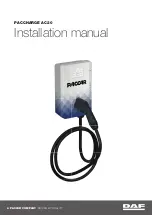
x
Do not release the parking brake lever until the engine starts to move the vehicle forward. You can
also depress and hold the brake pedal for added braking and then let up on the brake pedal when you
feel that the vehicle “wants” to move forward.
x
Drive ahead slowly.
WARNING
Improper trailer towing can cause loss of vehicle control and serious personal injury.
x
Driving with a trailer and carrying heavy or bulky items changes the way the vehicle
handles and increases the distance it needs to stop safely.
x
Always watch what is happening up ahead and around you. Brake earlier than you would
if you were not towing a trailer.
x
Always adapt your speed and driving to the heavier load and the weight distribution in the
vehicle. Take road, weather, traffic, and visibility conditions into account as well.
x
Reduce your speed even more than you otherwise would when going downhill and under
unfavorable load, weather, or wind conditions.
x
Drive especially carefully and accelerate gently. Always avoid sudden maneuvers and
hard braking.
x
Be especially careful when passing other vehicles.
x
Reduce speed immediately if the trailer shows even the slightest sign of swaying.
x
Never try to stop the swaying by accelerating.
x
Always obey speed limits. In some areas speed limits for vehicles towing trailers are lower
than for vehicles without trailers.
Ball mount
Fig. 101
Dimensions of the ball mount support.
¤
Please first read and note the introductory information and heed the WARNINGS
Your vehicle is not equipped with a trailer hitch or preparations for the installation of a trailer hitch. If
you must tow a trailer, you must have the necessary electrical wiring and socket together with a
suitable trailer hitch installed. Because towing a trailer places a great deal of stress on the vehicle, the
attachment of a trailer to the vehicle and the dimensions of the receiver and ball mount are very
important so that the extra forces the vehicle has to withstand can be properly handled.
The receiver used requires both a ball mount and a ball that meet special requirements regarding
geometry and size. This applies to both the height of the ball above the surface where it attaches
⇒
fig. 101
(A)
, and the pin-to-ball distance
(B)
.
















































